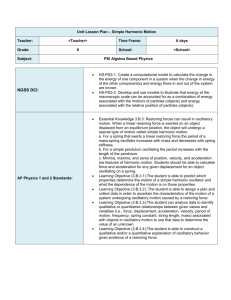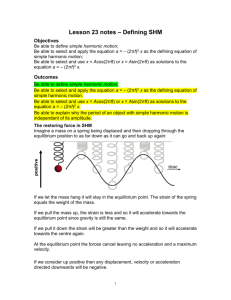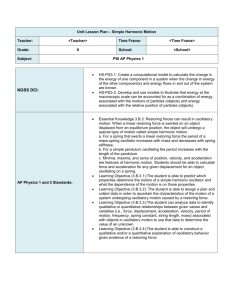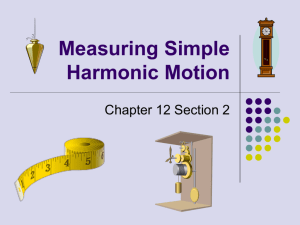Chapter 7 Notes
advertisement
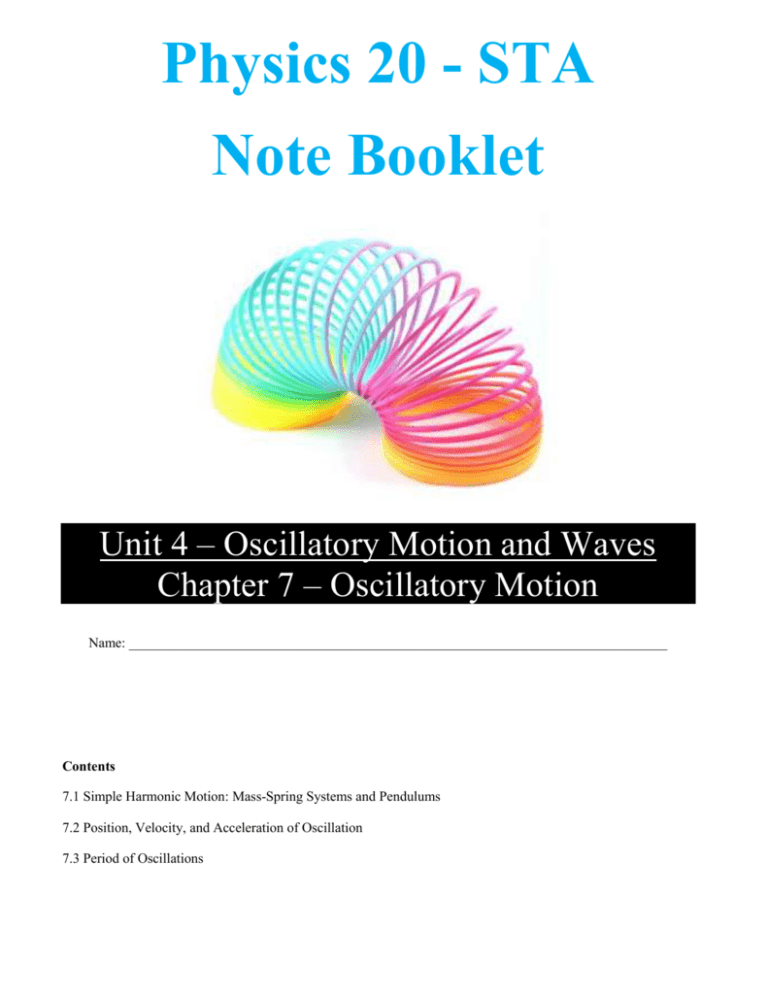
Physics 20 - STA Note Booklet Unit 4 – Oscillatory Motion and Waves Chapter 7 – Oscillatory Motion Name: ______________________________________________________________________________ Contents 7.1 Simple Harmonic Motion: Mass-Spring Systems and Pendulums 7.2 Position, Velocity, and Acceleration of Oscillation 7.3 Period of Oscillations 7.1 SIMPLE HARMONIC MOTION (MASS-SPRING SYSTEMS ) Many things in nature repeat themselves over and over as time passes. What is repeating in the following examples? All of these are examples of simple harmonic motion. Simple harmonic motion is motion that repeats itself over the same path. In each case, the object will eventually come to rest at an equilibrium position. Whenever the object is pulled away from its equilibrium position, a force pulls it back toward the equilibrium. If the restoring force varies linearly with the displacement from the equilibrium, the motion that results is called simple harmonic motion. Remember Hooke’s Law from last chapter… If we stretch the spring and let it go, then the ball will exhibit simple harmonic motion. An oscillation is a repetitive back and forth motion. One complete oscillation is called a cycle. Video on Oscillations - http://youtu.be/1M8ciWSgc_k The time required for the wings to make one complete oscillation is the period (T). If the period of each cycle remains constant, then the wings are moving up and down with oscillatory motion. Recall from Chapter 5 that the number of oscillations per second is the frequency (f), measured in hertz (Hz). The equation for frequency and period is: Simple Harmonic Motion of Horizontal Mass-Spring Systems We will use the following ideal spring to help us understand the relationship between oscillating motion and the restoring force. At equilibrium position, there is no tension in the spring and no restoring force acting on it. In the above pictures, the mass has returned to the position where it started, and one full oscillation has occurred. Throughout its entire motion, the mass-spring system obeys Hooke’s law. In other words, at any instant, the restoring force is proportional to the displacement of the mass. Any object that obeys Hooke’s law undergoes simple harmonic motion (SHM). SHM is oscillatory motion where the restoring force is proportional to the displacement of the mass. An object that moves with SHM is called a simple harmonic oscillator. SHM - Vertical Mass-Spring Systems If the mass is lifted to the position shown on the left and released, it will begin oscillating with simple harmonic motion. Its amplitude will equal its initial displacement. Regardless of the position of the mass, the force of gravity remains constant but the tension of the spring varies. In the position shown in Figures 7.21(b) and (d), the net (restoring) force is zero. This is where the spring’s tension is equal and opposite to the force of gravity. In the position shown in Figure 7.21(c), the displacement of the spring is equal to the amplitude, and the tension exerted by the spring is at its maximum. The mass experiences the greatest restoring force, which acts upward. When the mass is below the equilibrium position, the upward force exerted by the tension of the spring is greater than the gravitational force. So the net force — and therefore the restoring force — is upward. Above the equilibrium position, the downward force of gravity exceeds the upward tension of the spring, and the restoring force is downward. The values of velocity, acceleration, and restoring force change in exactly the same way that they do in a horizontal mass spring system. Example Problems 1. A mass of 2.0 kg is attached to a spring with a spring constant of 40.0 N/m on a horizontal frictionless surface. Determine the restoring force acting on the mass when the spring is compressed to a displacement of -0.15 m. 2. A spring is hung from a hook on a ceiling. When a mass of 510.0 g is attached to the spring, the spring stretches a distance of 0.500 m. What is the spring constant? 3. Five people with a combined mass of 275.0 kg get into a car. The car’s four springs are each compressed a distance of 5.00 cm. Determine the spring constant of the springs. Assume the mass is distributed evenly to each spring. SHM – Pendulum A simple pendulum is one which can be considered to be a point mass suspended from a frictionless string or rod of negligible mass. For small displacements, a swinging pendulum exhibits SHM. FR = Fg(sinθ) Example #1 - Determine the magnitude of the restoring force for a pendulum bob of mass 100.0 g that has been pulled to an angle of 10.0 from the vertical. [0.170 N] Practice Problems 1. Determine the restoring force of a pendulum that is pulled to an angle of 12.0 left of the vertical. The mass of the bob is 300.0 g. [0.612 N [right]] 2. At what angle must a pendulum be displaced to create a restoring force of 4.00 N [left] on a bob with a mass of 500.0 g? [54.6] 7.2 POSITION, VELOCITY, AND ACCELERATION OF OSCILLATION The acceleration of a horizontal mass-spring simple harmonic oscillator can be determined by its spring constant, displacement, and mass. It’s logical that the acceleration of the mass depends on how stiff the spring is and how far it is stretched from its equilibrium position. It is also reasonable to assume that, if the mass is large, then the acceleration will be small. This assumption is based on Newton’s second law. The acceleration depends on the displacement of the mass, so the acceleration changes throughout the entire motion as shown in Figure 7.29. Since acceleration of a simple harmonic oscillator is not uniform, only the instantaneous acceleration of the mass can be determined by equation 4. Earlier, you learned that two equations can be used to describe force in the mass-spring system: Newton’s second law and Hooke’s law. They can be written mathematically as: • Newton’s second law: Fnet = ma • Hooke’s law: F= -kx Since both equations refer to the restoring force, you can equate them: where a is the acceleration in metres per second squared; k is the spring constant in newton’s per metre; x is the displacement in metres; and m is the mass of the oscillator in kilograms. The acceleration of a simple harmonic oscillator is continually changing, so it should come as no surprise that the velocity changes too. As we have just seen, the maximum acceleration occurs when the oscillator is at its maximum displacement. At this position, it is tempting to think that the velocity will be at its maximum as well, but we know that this is not the case. Remember, the acceleration is at its greatest magnitude at the extremes of the motion, yet the oscillator has actually stopped in these positions! Three factors influence the maximum speed of a mass-spring system: • the amplitude of the oscillations: If the oscillator moves through a large amplitude, the restoring force increases in proportion to the amplitude. As the restoring force increases, so does the acceleration, and the oscillator will achieve a greater velocity by the time it reaches the equilibrium position. • the stiffness of the spring: A stiffer spring with a higher spring constant exerts a stronger restoring force and creates a greater maximum velocity for the same reasons that increasing the amplitude does. • the mass of the oscillator: Changing the mass of an oscillator has a different effect. If the mass increases, the velocity of the oscillations decreases. This is because the oscillator has more inertia. A larger mass is harder to accelerate so it won’t achieve as great a speed as a similar massspring system with less mass. To Solve for Max Speed of an Oscillating Mass Elastic Potential = Kinetic Energy Realize total mechanical energy stays the same (EtotA=EtotB) and solve for v of the kinetic energy. 1. Determine the acceleration of a 0.250 kg mass on the end of a 54.9 N/m spring if it has been a. Stretched 12 cm from its equilibrium and released b. Compressed 25 cm from its equilibrium and released 7.3 - PERIOD OF AN OSCILLATING MASS The larger the oscillating mass is, the longer its period of oscillation is. This seems reasonable since a large mass takes longer to speed up or slow down. It would also seem reasonable that the period should be inversely related to the spring constant, as the equation suggests. After all, the stiffer the spring, the more force it exerts over smaller displacements. Therefore, you could expect the mass to oscillate more quickly and have a smaller period. What is interesting about this equation is not what influences the period but what does not. It may seem odd that the displacement has no influence on the period of oscillation. This means that if you were to pull a massspring system to a displacement x and then let go, it would have the same period of oscillation as it would if you pulled it to a displacement of 2x and released it! The two identical mass-spring systems in Figure 7.40 have different amplitudes but the same period. This relationship is true for any simple harmonic oscillator, including a pendulum with a small amplitude. It is easy enough to test. Take two pendulums with the same mass and length (Figure 7.41). Pull both bobs back to different displacements. Remember to keep the displacements small so the pendulums oscillate with SHM. Release them at the same time. You will discover that both make one full oscillation in unison. This means they return to the point of release at exactly the same time. The pendulum that begins with the larger displacement has farther to travel but experiences a larger restoring force that compensates for this. where l is the length of the pendulum string in metres; and g is the gravitational field strength in newtons per kilogram. Recall that the length of the pendulum is always measured from the point where it is attached at the top, to the centre of mass of the bob, not the point at which the string or wire is attached to the bob. Also recall that the period of the pendulum’s swing does not depend on the mass of the pendulum bob. This may not seem logical but it is indeed the case — just as the acceleration of an object in free fall doesn’t depend on the mass of the object. 1. Determine the period of a pendulum that is 12.5m long (on Earth). 2. We decide to measure gravity in a particular location on Earth. I use a 2.75 m long pendulum and find that it has a period of 3.33 s. Determine the acceleration due to gravity in this area. 3. Determine the length of a pendulum that would have a period of one minute. This works for period of a mass-spring system 𝒎 𝑻 = 𝟐𝝅√ 𝒌 4. A 1.2kg object vibrates with a frequency of 0.75 Hz at the end of a horizontal spring along a frictionless surface. Determine the: a) Period of oscillation b) Spring constant
